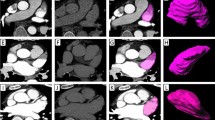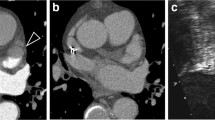Abstract
Objectives
To determine whether quantitative radiomic features from cardiac CT could differentiate the left atrial appendage (LAA) thrombus from circulatory stasis in patients with valvular heart disease.
Methods
Ninety-five consecutive patients with valvular heart disease and filling defects in LAA on two-phase cardiac CT from March 2016 to August 2018 were retrospectively enrolled and classified as having thrombus or stasis by transesophageal echocardiography or cardiac surgery. The ratio of Hounsfield units in the filling defects to those in the ascending aorta (AA) was calculated on early- and late-phase CT (LAA/AAE and LAA/AAL, respectively). Radiomic features were extracted from semi-automated three-dimensional segmentation of the filling defect on early-phase CT. The diagnostic ability of radiomic features for differentiating thrombus from stasis was assessed and compared to LAA/AAE and LAA/AAL by comparing the AUC of ROC curves. Diagnostic performances of CT attenuation ratios and radiomic features were validated with an independent validation set.
Results
Thrombus was diagnosed in 25 cases and stasis in 70. Sixty-eight radiomic features were extracted. Values of 8 wavelet-transformed features were lower in thrombus than in stasis (p < 0.001). The AUC value of a radiomic feature, wavelet_LHL, for diagnosing thrombus was 0.78, which was higher than that of LAA/AAE (AUC = 0.54, p = 0.025) and similar to that of LAA/AAL (AUC = 0.76, p = 0.773). In the validation set, the AUC of wavelet_LHL was 0.71, which was higher than that of LAA/AAE (AUC = 0.57, p = 0.391) and similar to that of LAA/AAL (AUC = 0.75, p = 0.707).
Conclusions
Quantitative radiomic features from the early phase of cardiac CT may help diagnose LAA thrombus in patients with valvular heart disease.
Key Points
• Wavelet-transformed grey-level non-uniformity values from radiomic analysis are significantly lower for LAA thrombus than for circulatory stasis.
• Radiomic features may have an additional value for differentiating LAA thrombus from circulatory stasis when interpreting single-phase cardiac CT.
• Radiomic features extracted from single-phase images may show similar diagnostic ability as conventional quantitative analysis from two-phase images.



Similar content being viewed by others
Abbreviations
- AA:
-
Ascending aorta
- AF:
-
Atrial fibrillation
- CI:
-
Confidence interval
- GLCM:
-
Grey-level co-occurrence matrix
- GLRLM:
-
Grey-level run-length matrix
- H:
-
High-pass filter
- ICC:
-
Intraclass correlation coefficient
- L:
-
Low-pass filter
- LAA:
-
Left atrial appendage
- TEE:
-
Transesophageal echocardiography
References
Al-Saady NM, Obel OA, Camm AJ (1999) Left atrial appendage: structure, function, and role in thromboembolism. Heart 82:547–554
Beigel R, Wunderlich NC, Ho SY, Arsanjani R, Siegel RJ (2014) The left atrial appendage: anatomy, function, and noninvasive evaluation. JACC Cardiovasc Imaging 7:1251–1265
(1994) Risk factors for stroke and efficacy of antithrombotic therapy in atrial fibrillation. Analysis of pooled data from five randomized controlled trials. Arch Intern Med 154:1449-1457
Ozkan M, Kaymaz C, Kirma C et al (1998) Predictors of left atrial thrombus and spontaneous echo contrast in rheumatic valve disease before and after mitral valve replacement. Am J Cardiol 82:1066–1070
Fatkin D, Kelly RP, Feneley MP (1994) Relations between left atrial appendage blood flow velocity, spontaneous echocardiographic contrast and thromboembolic risk in vivo. J Am Coll Cardiol 23:961–969
Doufekias E, Segal AZ, Kizer JR (2008) Cardiogenic and aortogenic brain embolism. J Am Coll Cardiol 51:1049–1059
Mirdamadi A, Mirmohammadsadeghi M, Marashinia F, Nourbakhsh M (2013) Left atrial appendage occlusion. Int J Prev Med 4:102–104
Zhan Y, Joza J, Al Rawahi M et al (2018) Assessment and management of the left atrial appendage thrombus in patients with nonvalvular atrial fibrillation. Can J Cardiol 34:252–261
Fuster V, Ryden LE, Cannom DS et al (2011) 2011 ACCF/AHA/HRS focused updates incorporated into the ACC/AHA/ESC 2006 guidelines for the management of patients with atrial fibrillation: a report of the American College of Cardiology Foundation/American Heart Association Task Force on practice guidelines. Circulation 123:e269–e367
Hilberath JN, Oakes DA, Shernan SK, Bulwer BE, D’Ambra MN, Eltzschig HK (2010) Safety of transesophageal echocardiography. J Am Soc Echocardiogr 23:1115–1127 quiz 1220-1111
Romero J, Husain SA, Kelesidis I, Sanz J, Medina HM, Garcia MJ (2013) Detection of left atrial appendage thrombus by cardiac computed tomography in patients with atrial fibrillation: a meta-analysis. Circ Cardiovasc Imaging 6:185–194
Hur J, Kim YJ, Lee HJ et al (2011) Dual-enhanced cardiac CT for detection of left atrial appendage thrombus in patients with stroke: a prospective comparison study with transesophageal echocardiography. Stroke 42:2471–2477
Teunissen C, Habets J, Velthuis BK, Cramer MJ, Loh P (2017) Double-contrast, single-phase computed tomography angiography for ruling out left atrial appendage thrombus prior to atrial fibrillation ablation. Int J Cardiovasc Imaging 33:121–128
Hur J, Kim YJ, Lee HJ et al (2012) Cardioembolic stroke: dual-energy cardiac CT for differentiation of left atrial appendage thrombus and circulatory stasis. Radiology 263:688–695
Nam K, Suh YJ, Han K, Park SJ, Kim YJ, Choi BW (2019) Value of computed tomography radiomic features for differentiation of periprosthetic mass in patients with suspected prosthetic valve obstruction. Circ Cardiovasc Imaging 12:e009496
Kolossvary M, Karady J, Szilveszter B et al (2017) Radiomic features are superior to conventional quantitative computed tomographic metrics to identify coronary plaques with napkin-ring sign. Circ Cardiovasc Imaging:10
Kolossvary M, Kellermayer M, Merkely B, Maurovich-Horvat P (2018) Cardiac computed tomography radiomics: a comprehensive review on radiomic techniques. J Thorac Imaging 33:26–34
Daimee MA, Salama AL, Cherian G, Hayat NJ, Sugathan TN (1998) Left atrial appendage function in mitral stenosis: is a group in sinus rhythm at risk of thromboembolism? Int J Cardiol 66:45–54
Chiang CW, Lo SK, Ko YS, Cheng NJ, Lin PJ, Chang CH (1998) Predictors of systemic embolism in patients with mitral stenosis. A prospective study. Ann Intern Med 128:885–889
Vigna C, Russo A, De Rito V et al (1992) Frequency of left atrial thrombi by transesophageal echocardiography in idiopathic and in ischemic dilated cardiomyopathy. Am J Cardiol 70:1500–1501
Hur J, Kim YJ, Lee HJ et al (2009) Left atrial appendage thrombi in stroke patients: detection with two-phase cardiac CT angiography versus transesophageal echocardiography. Radiology 251:683–690
Kim SC, Chun EJ, Choi SI et al (2010) Differentiation between spontaneous echocardiographic contrast and left atrial appendage thrombus in patients with suspected embolic stroke using two-phase multidetector computed tomography. Am J Cardiol 106:1174–1181
DeLong ER, DeLong DM, Clarke-Pearson DL (1988) Comparing the areas under two or more correlated receiver operating characteristic curves: a nonparametric approach. Biometrics 44:837–845
Tani T, Yamakami S, Matsushita T et al (2003) Usefulness of electron beam tomography in the prone position for detecting atrial thrombi in chronic atrial fibrillation. J Comput Assist Tomogr 27:78–84
Kawaji T, Numamoto H, Yamagami S et al (2019) Real-time surveillance of left atrial appendage thrombus during contrast computed tomography imaging for catheter ablation: THe Reliability of cOMputed tomography Beyond UltraSound in THROMBUS detection (THROMBUS) study. J Thromb Thrombolysis 47:42–50
Sawit ST, Garcia-Alvarez A, Suri B et al (2012) Usefulness of cardiac computed tomographic delayed contrast enhancement of the left atrial appendage before pulmonary vein ablation. Am J Cardiol 109:677–684
Li R, Xing L, Napel S, Rubin DL (2019) Radiomics and radiogenomics: technical basis and clinical applications (imaging in medical diagnosis and therapy), 1st edn. Chapman and Hall/CRC, USA
Acknowledgements
This work was supported by the National Research Foundation of Korea (NRF) grant funded by the Korean government (MSIT) (2018R1C1B6007251) and a faculty research grant of Yonsei University College of Medicine (6-2018-0041).
Funding
This work was supported by the National Research Foundation of Korea (NRF) grant funded by the Korea government (MSIT) (2018R1C1B6007251) and a faculty research grant of Yonsei University College of Medicine (6-2018-0041).
Author information
Authors and Affiliations
Corresponding author
Ethics declarations
Guarantor
The scientific guarantor of this publication is Byoung Wook Choi.
Conflict of interest
Dr. Sang Joon Park is CEO of MEDICAL IP.
Statistics and biometry
One of the authors, Dr. Kyunghwa Han, has significant statistical expertise.
Informed consent
Written informed consent was waived by the institutional review board.
Ethical approval
Institutional review board approval was obtained.
Methodology
• retrospective
• diagnostic or prognostic study
• performed at one institution
Additional information
Publisher’s note
Springer Nature remains neutral with regard to jurisdictional claims in published maps and institutional affiliations.
Electronic supplementary material
ESM 1
(DOCX 169 kb)
Rights and permissions
About this article
Cite this article
Chun, S.H., Suh, Y.J., Han, K. et al. Differentiation of left atrial appendage thrombus from circulatory stasis using cardiac CT radiomics in patients with valvular heart disease. Eur Radiol 31, 1130–1139 (2021). https://doi.org/10.1007/s00330-020-07173-1
Received:
Revised:
Accepted:
Published:
Issue Date:
DOI: https://doi.org/10.1007/s00330-020-07173-1




